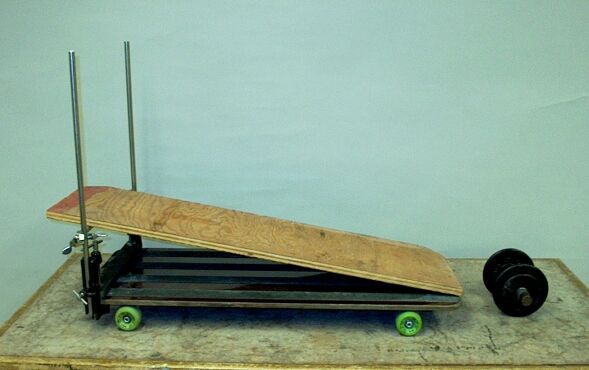
Place the dumbbell at the top of the ramp, then release it. As gravity accelerates the dumbbell to the right, it also accelerates the skateboard to the left. When the dumbbell rolls off the bottom end of the ramp, it and the skateboard continue in opposite directions at constant velocity (except as they are slowed by friction). Installing a rod across the bottom of the ramp, to stop the dumbell (optional), causes the whole system to come to a stop when the dumbbell reaches the bottom. If you wish, you can adjust the height of the top of the ramp by loosening the clamps that hold the rod that supports it, moving it to the desired height and retightening the clamps. (This demonstration is set up on the floor in front of the main demonstration table. It is shown above sitting on a rolling table for purposes of photography.)
The purpose of this demonstration is to illustrate the conservation of linear momentum. When you place the dumbbell at the top of the ramp, before you release it, the skateboard-dumbbell system is at rest; its momentum is zero. When you release the dumbbell, gravity pulls it downwards, and the ramp resolves gravity into two components, one normal to the ramp, and the other parallel to the ramp, which causes the dumbbell to roll down the ramp. Except that the dumbbell rolls, and that the skateboard can also roll, this situation is similar to that of a block on an inclined plane (demonstration 12.69 – Slide blocks down incline). The normal force between the dumbbell and the ramp has a horizontal component, which causes the skateboard and ramp to accelerate in one direction (to the left for the ramp and skateboard as shown in the photograph), while the dumbbell rolls downwards in the opposite direction (to the right for the system as shown in the photograph).
We will call the mass of the skateboard and ramp M, and that of the dumbell m, and if we wish to include the rolling motion of the dumbbell, its moment of inertia I. The angle of the ramp with respect to horizontal is θ. Since the ramp is moving sideways as the dumbbell rolls down it, the total momentum is p = MvM + m(vm cos θ + vM) + Iω, or p = MvM + m(vm cos θ + vM) + I(vm + vM cos θ)/r, where r is the radius of the dumbbell. If we consider the dumbbell as a disk with radius r, then I = mr2/2, and Iω = (mr/2)(vm + vM cos θ). (vM is in the horizontal direction, and vm is along a line parallel to the surface of the ramp.) At the beginning, p = 0. When you release the dumbbell at the top of the ramp, as the dumbbell is accelerated down the ramp, and the skateboard is accelerated horizontally, both gain momentum, but the sum of their momenta must always equal zero, as it did at the beginning. Hence, as the dumbbell rolls down the ramp, at any point, MvM = -m[(vm cos θ + vM) + (r/2)(vm + vM cos θ)]. We can rearrange this to [M + m + (mr/2) cos θ)]vM = -(m cos θ + mr/2)vm. (If we neglect the rolling motion of the dumbbell, this works out to the somewhat less cumbersome equation (M + m)vM = -mvm cos θ.) Once the dumbbell leaves the bottom of the ramp, this still holds, and as noted above, except as they are slowed by friction, the skateboard and dumbbell roll off in opposite directions, at the velocities they had when the dumbbell reached the bottom, their momenta equal and opposite.
If you clamp the optional stop rod at the bottom of the ramp, then during the dumbbell’s trip down the ramp, the skateboard accelerates in the opposite direction to that in which the dumbbell rolls, as before. When the dumbbell is stopped by the rod at the bottom of the ramp, however, it exchanges its momentum with that of the skateboard. Since their momenta are equal and opposite, they sum to zero, and the whole system comes to rest.